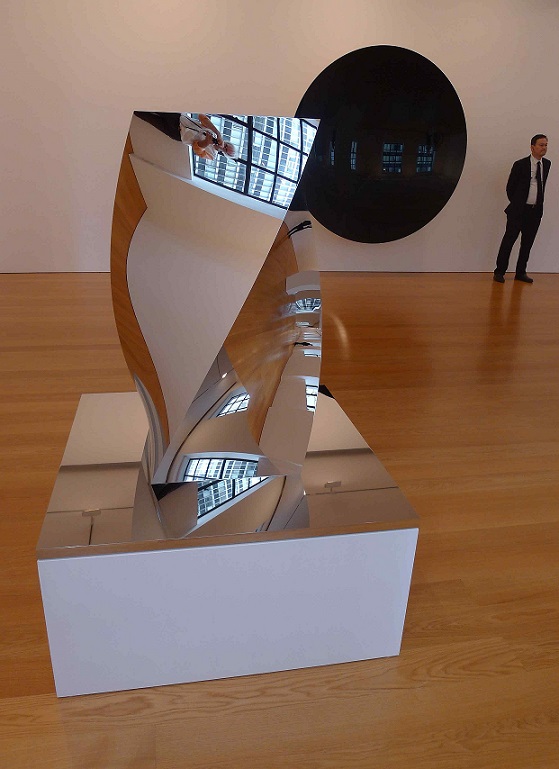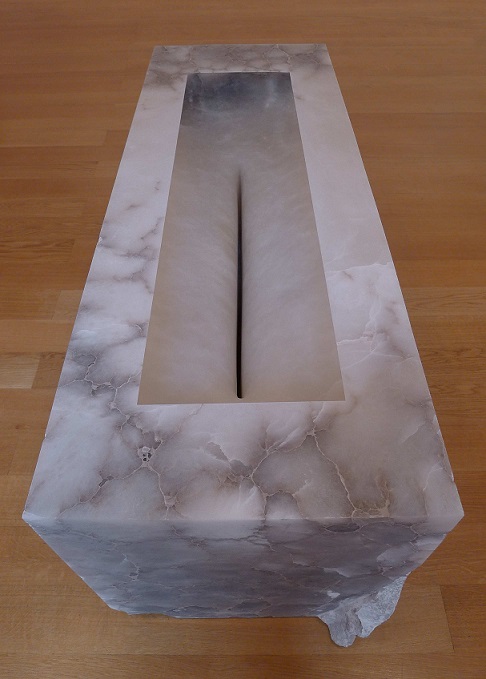藝評
Anish Kapoor
約翰百德 (John BATTEN)
at 10:41pm on 19th October 2016





Captions:
1. Anish Kapoor, Vertigo, 2006
2. Anish Kapoor, Hysterical Sexual, 2016
3. & 4. Anish Kapoor, Right Angle Triangle Twist (foreground) and Mirror (Black) (rear), both 2016
5. Anish Kapoor, Stone Saddle, 2016
Photographs: John Batten, courtesy of Gagosian Gallery
(原文以英文發表,評論〈安尼施‧卡普爾個展〉。)
A 5-day visit to Uluru (Ayer’s Rock) in the Central Australian desert nearly thirty years ago gave Indian/British sculptor Anish Kapoor significant insight into his future work. Interviewed for a retrospective at the Institute of Contemporary Art in Boston in 2008, Kapoor said the rock was a place that was “fully formed, pure, essential, unencumbered by making.” Kapoor walked the perimeter of the rock and “unbelievable things revealed themselves every day. I felt deeply connected with it, and with a kind of possible interpretation, a symbolic interpretation of the holes and the strips of stone that seem to be leaning against it.” It was here that he envisaged a “white form on a white wall”, which resulted in his seminal past work, I am Pregnant (1992). Kapoor constructed a rounded white protuberance, like a swollen pregnancy, emerging from a white wall. The bulge is undetectable when seen from the front, but the contours of the form and surrounding space are revealed when seen at an angle.
Kapoor’s infinity of space, originally experienced in I am Pregnant, has progressed and further permutations can be seen in this striking exhibition. Kapoor continues to explore the notion of endless space, the void, but “…the idea of place has always been very important to my work. A place that is, in a sense, original. I mean, by the word original, to do with ‘first’, and I think that is to do with centering oneself – allowing a thing to occur specifically rather than in general. A lot of my works are about passage, about a passing through, and that necessitates a place.” Gagosian’s high-ceilinged rectangular gallery is a rarefied place. But, the fully framed windows and muted, reflected natural light allows great clarity and unadorned starkness to the exhibited sculpture, to be appreciated as either individual pieces or as a synergetic group.
Splitting the gallery is Vertigo, a single solid slab of standing concave/convex sided stainless steel positioned in the middle of the exhibition. Its highly polished mirrored surface replicates feelings of vertigo: walking towards it gives an uncanny sense of magnified closeness and a temptation to fall into the work - or, fall down. Mirrors are seductive; and Kapoor’s mirrored sculpture is a narcissist’s treat. However, the attraction of self-admiration wanes. The viewer’s attention “passes through”, up and down the gallery. Vertigo’s sightlines give new angles of changing reflected light and space.
Mirror (Black) is a large circular concave wall-mounted sculpture that best displays “the skin, the outermost covering” that is, Kapoor explains, “for me the place of action. It is the moment of contact between the thing and the world.” This blackest-of-black object silently sits on the wall and mirrors everything in its vision. The mirrored effect quickly oscillates between the precision of a hyperrealist painting and a close-up clip of psychedelic cinema. As with Mirror (Black), the stainless steel Right Angle Triangle Twist offers, however, another reality that complements the mirror effect. Kapoor explains that “the spatial questions it seems to ask were not about deep space but about present space…and they seem to be very active, to be in various states of becoming….”
In contrast, sculpture’s classicism is at its most intriguing, accomplished best with Stone Saddle. The rough-hewn outer edges of alabaster differ in intended aesthetics alongside the sculpture’s smooth impossibly curved void: it is a gash of sex, or prosaically, a bottomless water trough. Less successful is the overtly curvaceous sexuality of Hysterical Sexual, a fiberglass and gold edition, and the corner wall-mounted stainless steel Clip.

Anish Kapoor, Chamber 3, 2016
Before actually appreciating the carved interior of Chamber 3 the artist’s pencil drawing of the sculpture’s intended shape can be seen on the alabaster exterior and anticipates what is seen inside. The three interconnected carved inner chambers are painted in gold leaf and exude an internally generated luminosity. Seen is a sectioned view of classic-like design and symbolic gold richness that strongly contrasts with the raw stone exterior.
Despite the big studio fabrication of much of Kapoor’s sculpture, the aesthetics of beauty, artistic intrigue and the endless possibilities of space make this a rare and essential exhibition in Hong Kong for anyone interested in contemporary sculpture that successfully crosses global and cultural boundaries – and executed with exemplary intelligence.
Link for further info:
'Anish Kapoor' @ Gagosian Gallery
A version of this review was published in the South China Morning Post, 8 October 2016.
原文刊於《南華早報》,2016年10月8日。
